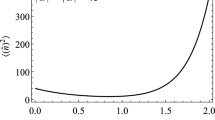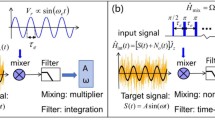Abstract
Decoherence of a two-level system is studied when it interacts with one of two environments via a dephasing coupling, where the environments are treated as classical and quantum systems. The situation is considered in which the environment that actually interacts with the two-level system is determined by a state of an ancillary two-level system. When information conveyed by the ancillary two-level system is discarded, the reduced dynamics of the relevant two-level system is described by a statistical mixture of two dephasing channels, which shows mixing-induced non-Markovianity. When projective measurement is performed on the ancillary two-level system to extract some information, the diagonal elements of the reduced state of the two-level system depend on time in spite of the dephasing process. Furthermore, it is found that the coherence of the two-level system can exceed its initial value. The parameter region is clarified in which the measurement on the ancillary two-level system can improve the coherence of the relevant two-level system. In particular, when the two environments are equivalent and the ancillary two-level system is in the maximally coherent state, the coherence of the two-level system can be always enhanced by measurement.








Similar content being viewed by others
References
Streltsov, A., Adesso, G., Plenio, M.B.: Quantum coherence as a resource. Rev. Mod. Phys. 89, 041003 (2014)
Horodecki, R., Horodecki, P., Horodecki, M., Horodecki, K.: Quantum entanglement. Rev. Mod. Phys. 81, 865 (2009)
Reid, M.D., Drummond, P.D., Bowen, W.P., Cavalcanti, E.G., Lam, K.P., Bachor, H.A., Andersen, U.L., Leuchs, G.: The Einstein–Podolsky–Rosen paradox: from concepts to applications. Rev. Mod. Phys. 81, 1727 (2009)
Brunner, N., Cavalcanti, D., Pironio, S., Scarani, V., Wehner, S.: Bell nonlocality. Rev. Mod. Phys. 86, 419 (2014)
Emary, C., Lambert, N., Nori, F.: Leggett–Garg inequalities. Rep. Prog. Phys. 77, 016001 (2014)
Bell, J.S.: Speakable and Unspeakable in Quantum Mechanics. Cambridge University Press, Cambridge (1987)
Peres, A.: Quantum Theory: Concepts and Methods. Kluwer, Dordrecht (1993)
Nielsen, M.A., Chuang, I.L.: Quantum Computation and Quantum Information. Cambridge University Press, Cambridge (2000)
Bennett, C.H., Brassard, G.: Quantum cryptography: public key distribution and coin tossing. Theor. Comput. Sci. 560, 7 (2014)
Ekert, A.K.: Quantum cryptography based on Bell’s theorem. Phys. Rev. Lett. 67, 661 (1991)
Bennett, C.H., Brassard, G., Crepeau, C., Jozsa, R., Peres, A., Wootters, W.K.: Teleporting an unknown quantum state via dual classical and Einstein-Podolsky-Rosen channels. Phys. Rev. Lett. 70, 1895 (1993)
Bennett, C.H., Wiesner, S.J.: Communication via one- and two-particle operators on Einstein–Podolsky–Rosen states. Phys. Rev. Lett. 69, 2881 (1992)
Deutsch, D.: Quantum theory, the Church-Turing principle and the universal quantum computer. Proc. R. Soc. A 400, 1818 (1985)
Deutsch, D., Jozsa, R.: Rapid solution of problems by quantum computation. Proc. R. Soc. Lond. A 439, 553 (1992)
Gallager, R.G.: Information Theory and Reliable Communication. Wiley, New York (1968)
Cover, T.M., Thomas, J.A.: Elements of Information Theory. Wiley, New York (1991)
Kubo, R., Toda, M., Hashitsume, N.: Statistical Physics II. Springer, Berlin (1985)
Weiss, U.: Quantum Dissipative Systems. World Scientific, Singapore (1993)
Carmichael, H.: An Open Quantum Systems: Approach to Quantum Optics. Springer, Berlin (1991)
Breuer, H.P., Petruccione, F.: The Theory of Open Quantum Systems. Oxford University Press, Oxford (2006)
Viola, L., Lloyd, S.: Dynamical suppression of decoherence in two-state quantum systems. Phys. Rev. A 58, 2733 (1998)
Ban, M.: Photon-echo technique for reducing the decoherence of a quantum bit. J. Mod. Opt. 45, 2315 (1998)
Vitali, D., Tombesi, P.: Using parity kicks for decoherence control. Phys. Rev. A 59, 4178 (1999)
Uchiyama, C., Aihara, M.: Multipulse control of decoherence. Phys. Rev. A 66, 032313 (2002)
Falci, G., D’Arrigo, M., Mastellone, A., Paladino, E.: Dynamical suppression of telegraph and \(1/f\) noise due to quantum bistable fluctuators. Phys. Rev. A 70, 040101 (2004)
Khodjasteh, K., Lidar, D.A.: Fault-tolerant quantum dynamical decoupling. Phys. Rev. Lett. 95, 180501 (2005)
Gutmann, H., Wilhelm, F.K., Kaminsky, W.K., Lloyd, S.: Compensation of decoherence from telegraph noise by means of an open-loop quantum-control technique. Phys. Rev. A 71, 020302 (2005)
Santos, L.F., Viola, L.: Dynamical control of qubit coherence: random versus deterministic schemes. Phys. Rev. A 72, 062303 (2005)
Shor, P.: Scheme for reducing decoherence in quantum computer memory. Phys. Rev. A 52, R2493 (1995)
Steane, A.M.: Error correcting codes in quantum theory. Phys. Rev. Lett. 77, 793 (1996)
Zanardi, P., Resetti, M.: Noiseless quantum codes. Phys. Rev. Lett. 79, 3306 (1997)
Lidar, D.A., Chuang, I.L., Whaley, K.B.: Decoherence-free subspaces for quantum computation. Phys. Rev. Lett. 81, 2594 (1998)
Korotkov, A.N., Keane, K.: Decoherence suppression by quantum measurement reversal. Phys. Rev. A 81, 040103 (2010)
Sun, Q., Al-Amri, M., Luiz, D., Suhail, Z.M.: Reversing entanglement change by a weak measurement. Phys. Rev. A 82, 052323 (2010)
Kim, Y.S., Lee, J.C., Kwon, O., Kim, Y.H.: Protecting entanglement from decoherence using weak measurement and quantum measurement reversal. Nat. Phys. 8, 117 (2012)
Wang, S.C., Yu, Z.W., Zou, W.J., Wang, X.B.: Protecting quantum states from decoherence of finite temperature using weak measurement. Phys. Rev. A 89, 022318 (2014)
Li, W.J., He, Z., Wang, Q.: Protecting distribution entanglement for two-qubit state using weak measurement and reversal. Int. J. Theor. Phys. 56, 2813 (2017)
Wang, Q., Tang, J.S., He, Z., Yuan, J.B.: Decoherence suppression in phase decoherence environment using weak measurement and quantum measurement reversal. Int. J. Theor. Phys. 57, 3682 (2018)
Xiao, X., Fang, M.F., Li, Y.L.: Non-Markovian dynamics of two qubits driven by classical fields: population trapping and entanglement preservation. J. Phys. B 43, 185505 (2010)
Li, Y.L., Xiao, X., Yao, Y.: Classical-driving-enhanced parameter-estimation precision of a non-Markovian dissipative two-state system. Phys. Rev. A 91, 052105 (2015)
Ren, Y.K., Tang, L.M., Zeng, H.S.: Protection of quantum Fisher information in entangled states via classical driving. Quantum Inf. Process. 15, 5011 (2016)
Huang, Z., Situ, H.: Non-Markovian dynamics of quantum coherence of two-level system driven by classical field. Quantum Inf. Process. 16, 222 (2017)
Gholipour, H., Mortezapour, A., Nosrati, F., Franco, R.L.: Quantumness and memory of one qubit in a dissipative cavity under classical control. Ann. Phys. 414, 168073 (2020)
Mortezapour, A., Nourmandipour, A., Gholipour, H.: The effect of classical driving field on the spectrum of a qubit and entanglement swapping inside dissipative cavities. Quantum Inf. Process. 19, 136 (2020)
Chiribella, G.: Perfect discrimination of no-signalling channels via quantum superposition of causal structures. Phys. Rev. A 86, 040301 (2012)
Chiribella, G., D’Ariano, G.M., Perinotti, P., Valiron, B.: Quantum computations without definite causal structure. Phys. Rev. A 88, 022318 (2013)
Ibnouhsein, I., Grinbaum, A.: Information-theoretic constraints on correlations with indefinite causal order. Phys. Rev. A 92, 042124 (2015)
Ebler, D., Salek, S., Chiribella, G.: Enhanced communication with the assistance of indefinite causal order. Phys. Rev. Lett. 120, 120502 (2018)
Salek, S., Ebler, D., Chiribella, G.: Quantum communication in a superposition of causal orders. LANL arXiv: 1809.06655 [quant-ph] (2018)
Chiribella, G., Banik, M., Bhattacharya, S.S., Guha, T.: Indefinite causal order enables perfect quantum communication with zero capacity channel. LANL arXiv: 1810.10457 [quant-ph] (2018)
Goswami, K., Giarmatzi, C., Kewming, M., Costa, F., Branciard, C., Romero, J., White, A.G.: Indefinite causal order in a quantum switch. Phys. Rev. Lett. 121, 090503 (2018)
Guerin, P.A., Rubino, G., Brukner, C.: Communication through quantum-controlled noise. Phys. Rev. A 99, 062317 (2019)
Jia, D., Costa, F.: Causal order as a resource for quantum communication. Phys. Rev. A 100, 052319 (2019)
Guo, Y., Hu, X.M., Hou, Z.B., Cao, H., Cui, J.M., Liu, B.H., Huang, Y.F., Li, C.F., Guo, G.C., Chiribella, G.: Experimental transmission of quantum information using a superposition of causal orders. Phys. Rev. Lett. 124, 030502 (2020)
Loizeau, N., Grinbaum, A.: Channel capacity enhancement with indefinite causal order. Phys. Rev. A 101, 012340 (2020)
Procopio, L.M., Delgado, F., Enriquez, M., Belabas, N., Levenson, J.A.: Sending classical information via three noisy channels in superposition of causal orders. Phys. Rev. A 101, 012346 (2020)
Mukhopadhyay, C., Pati, A.K.: Superposition of causal order enables perfect quantum teleportation with very noisy singlets. LANL arXiv: 1901.07626 [quant-ph] (2019)
Cardoso-Isidoro, C., Delgado, F.: Featuring causal order in teleportation of two quantum teleportation channels. LANL arXiv: 1911.04550 [quant-ph] (2019)
Zhao, X., Yang, Y., Chiribella, G.: Quantum metrology with indefinite causal order. LANL arXiv: 1912.02449 [quant-ph] (2019)
Oi, D.K.L.: Interference of quantum channels. Phys. Rev. Lett. 91, 067902 (2002)
Gisin, N., Linden, N., Massar, S., Popescu, S.: Error filtration and entanglement purification for quantum communication. Phys. Rev. A 72, 012338 (2005)
Chiribella, G., Kristjánsson, H.: Quantum Shannon theory with superpositions of trajectories. Proc. R. Soc. A 475, 20180903 (2019)
Kristjánsson, H., Chiribella, G., Salek, S., Ebler, D., Wilson, M.: Resource theories of communication. New J. Phys. 22, 073014 (2020)
Abbott, A.A., Wechs, J., Horsman, D., Mhalla, M., Branciard, C.: Communication through coherent control of quantum channels. LANL arXiv: 1810.09826 [quant-ph] (2018)
Rubino, G., Rozema, L.A., Ebler, D., Kristjánsson, H., Salek, S., Guérin, P.A., Abbott, A.A., Branciard, C., Brukner, C., Chiribella, G., Walther, P.: Experimental quantum communication enhancement by superposing trajectories. LANL arXiv: 2007.05005 [quant-ph] (2019)
Breuer, H.P., Amato, G., Vacchini, B.: Mixing-induced quantum non-Markovianity and information flow. New J. Phys. 20, 043007 (2018)
Aharonov, Y., Anandan, J., Popescu, S., Vaidman, L.: Superposition of time evolutions of a quantum system and a quantum time-translation machine. Phys. Rev. Lett. 64, 2965 (1990)
Yu, T., Eberly, J.H.: Sudden death of entanglement: classical noise effects. Opt. Commun. 264, 393 (2006)
Benedetti, C., Paris, M.G.A., Maniscalco, S.: Non-Markovianity of colored noisy channels. Phys. Rev. A 89, 012114 (2014)
Daniotti, S., Benedetti, C., Paris, M.G.A.: Qubit systems subject to unbalanced random telegraph noise: quantum correlations, non-Karkovianity and teleportation. Eur. Phys. J. D 72, 208 (2018)
van Kampen, N.G.: Stochastic Processes in Physics and Chemistry. Elsevier, Amsterdam (1983)
Luczka, J.: Spin in contact with thermostat: exact reduced dynamics. Physica A 167, 919 (1990)
Morozov, V.G., Mathey, S., Röpke, G.: Decoherence in an exactly solvable qubit model with initial qubit-environment correlations. Phys. Rev. A 85, 022101 (2012)
Usui, R., Ban, M.: Temporal nonlocality of a two-level system interacting with a dephasing environment. Quantum Inf. Process. 19, 159 (2020)
Author information
Authors and Affiliations
Corresponding author
Additional information
Publisher's Note
Springer Nature remains neutral with regard to jurisdictional claims in published maps and institutional affiliations.
The relaxation and phase parameters in the Ohmic-like dissipation
The relaxation and phase parameters in the Ohmic-like dissipation
We derive explicit expressions for the relaxation and phase parameters, \(\gamma _{j}(t)\) and \(\theta _{j}(t)\), when the environment \(E_{j}\) has the Ohmic-like dissipation. Taking a continuum limit as \(4\sum _{k}\vert g_{j,k}\vert ^{2}F(\omega _{k}) \rightarrow \int _{0}^{\infty }\text {d}w\,J_{j}(w)F(w)\) with a spectral function \(J_{j}(w)\) of the jth environment \(E_{j}\), we obtain the relaxation and phase parameters from Eqs. (75) and (76)
The spectral function of the Ohmic-like environment [20, 72, 73] is given by
where \(\lambda _{j}\) stands for a coupling strength between the two-level system Q and the environment \(E_{j}\), \(\varOmega _{j}\) is a cutoff frequency and \(s_{j}\) represents an Ohmicity parameter of the environment \(E_{j}\) which is referred to as the sub-Ohmic, Ohmic and super-Ohmic environment, according to \(0<s_{j}<1\), \(s_{j}=1\) and \(1<s_{j}\). Then, the phase parameter \(\theta _{j}(t)\) and the relaxation parameter \(\gamma _{j}(t)\) [73, 74] are calculated to be
for \(s_{j}=1\) and
for \(s_{j}\ne 1\), where \(g_{s}(z)\) is given by
The asymptotic value of the relaxation parameter is
with \(\zeta (s,a)=\sum _{n=0}^{\infty }(n+a)^{-s}\). We note that the coherence of the two-level system Q remains finite in the asymptotic limit unless \(\lim _{t\rightarrow \infty }\gamma _{j}(t)=\infty \) [73]. It is also known that the reduced time-evolution of the two-level system Q which is caused by the environment \(E_{j}\) is Markovian (non-Markovian) if \(s_{j}\le 2\) (\(s_{j}>2\)).
Rights and permissions
About this article
Cite this article
Ban, M. Decoherence of a two-level system in a coherent superposition of two dephasing environments. Quantum Inf Process 19, 409 (2020). https://doi.org/10.1007/s11128-020-02903-2
Received:
Accepted:
Published:
DOI: https://doi.org/10.1007/s11128-020-02903-2




